Summary
An integrated computational materials engineering (ICME) approach is employed to link experimental and computational models across a variety of time and length scales to design new structural materials and optimize existing materials. Experimental and computational thermodynamics and kinetics are used to identify and model key processing-structure-property relations for specific material systems. The models and data developed for the key processing-structure-property relations form the basis for the alloy design methodologies and will enable industry to tailor materials to specific application property objectives. The current project focus is on the development of high temperature Co-based superalloys, the development of new materials specifically designed AM processing, and the optimization of currently used AM materials.
Description
Designing New High Temperature Co Superalloys
In collaboration with the NIST CHiMaD center, an ICME approach in being used to develop new Co superalloys that are strengthened using an ordered FCC (L12) phase (similar to the related Ni-based superalloys). The design goals for these alloys include:
- Increased homologous operating temperature (> 50 degrees higher that current Ni-based superalloys), which will increase the turbine engine efficiency and thus decrease fuel consumption and emissions.
- Increased wear resistance, which will increase the service life of the engine and lower operational costs.
The current NIST effort is focused on developing the required CALPHAD-based thermodynamic, diffusion, and molar volume databases to enable this design. The database development is focused on the Co-Al-W-Ni-Cr-Ti-Ta-V-Re. The thermodynamic database includes available binary and ternary sub-system descriptions from the literatures, re-assessment of key sub-systems related to the Co-based g-g' phase regions, and improved descriptions of the topological closed-packed (TCP) phases (µ, c, σ and Laves (C14, C15 and C36)) using destiny-functional theory data. The TCP phases are modeled using DFT data with the new Effective Bond Energy Formalism (EBEF), which uses decomposes the Gibbs energies of the endmember compounds into effective bond energies, This reduces the number of DFT data needed to fully describe a given phase significantly.
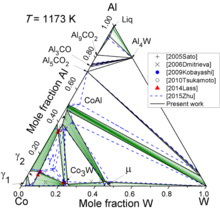

A compatible Co-Ni based diffusion mobility database for the FCC phase for the Co-Al-W-Ni-Cr-Ti-Ta-Re system has been developed. The databases is based on previous binary and ternary assessments, as well as additional experimental diffusion couple measurements. The current database was validated using available quaternary and quinary diffusion couples.
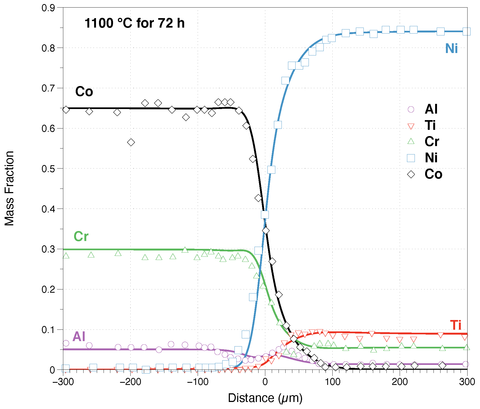
Current efforts are focused on using the revised database to design new prototype Co-based superalloys for wrought and additive manufacturing processing.
Optimization of Additive Manufacturing Processes and Alloys
Metal additive manufacturing has opened new design spaces as the potential now exists to build parts with location-specific properties. However, the rapid solidification followed by multiple heating and cooling cycles during the build process can produced unexpected phases and composition variations. Post-build thermal processing can be optimized to ensure that the desired properties are achieved. For example, precipitation simulations can be used to determine how to avoid the precipitation of detrimental phases during stress-relieving processing. New alloys are being designed specifically for the additive manufacturing that have smaller freezing range to reduce microsegregation and residual stresses. Current alloy systems of interest include martensitic stainless steels (17-4 PH), Ni-base superalloys (IN625 and IN718), and Co-base superalloys.
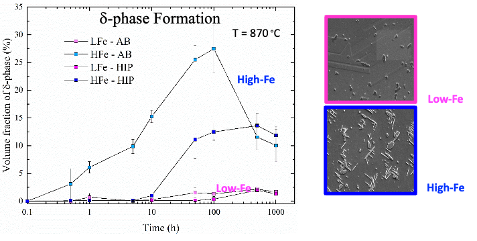
System for AM Metal Alloy Development (SAMAD)
To accelerate the design of new alloys for additive manufacturing and to investigate alternate processing methods, a custom built laser powder-blown directed energy deposition system is being developed. Laser powder-blown DED has become a major focus within AM due to flexible processing (e.g., > 5-axis processing and functionally graded material capability). The process consists of a nozzle that uses carrier gas, such as argon, to blow powders onto a substrate where a laser melts the deposited powders and substrate; the nozzle and laser can either move in tandem or the workpiece is translated below such that individual tracks and layers are created. Multiple layers of deposition and re-melting leads to a fully realized metal part.
This rapid-deposition technology will be used to screen new alloy systems or quickly evaluate a variety of feasible compositions. The DED system at NIST consists of a coaxial ring nozzle, two electrostatic powder feeders, and it is built on a hybrid manufacturing platform with machining capabilities. Two lasers can be used with the system: (1) a single-mode laser with a Gaussian distribution and (2) a multi-mode laser with both Gaussian and ring mode distributions. This multi-functional platform will enable fundamental connections between process and material structure and address the gap in alloy development for metal AM.
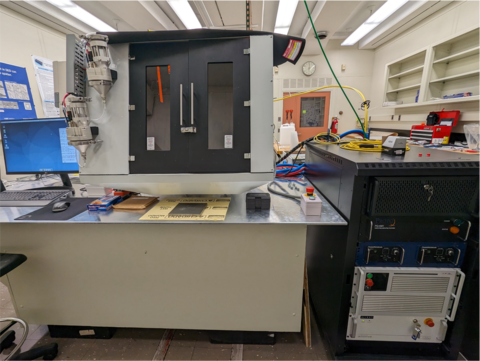
Modeling Creep in Superalloys
A crystal plasticity finite element framework is utilized in conjunction with morphology- and composition-dependent constitutive models is used to predict the mechanical properties in superalloys, such as the stress-strain creep behavior. A multi-scale approach is implemented to develop a constitutive model that is morphology-dependent. In addition, a composition-dependent constitutive model is developed for the slip-system resistance, as the active slip-systems are dependent on the alloy composition.
Co-based superalloys exhibit an anomalous flow stress behavior that must be included in the model. The flow stress decreases almost linearly from room temperature to 600 oC then then there are anomalies cause the flow stress to rise from 600 oC to 800oC following a fast decline at higher temperatures. Recent studies have shown Ti additions to have a positive impact on the flow stress in Co-based superalloys.
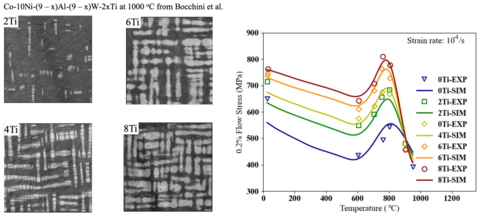
At a given temperature if the dislocations lack of sufficient energy to cut through the precipitates, this results in the dislocation climbing the precipitates and gliding across the channel. Hence, a glide and climb constitutive model is applied to capture the creep properties of superalloys.
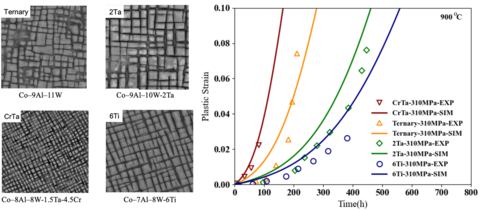
New High Temperature Thermal Analysis Reference Materials
The uncertainty associated with high temperature thermal analysis is often hampered by the lack of suitable reference calibration materials between the melting point of Au (1064 oC) and the melting of Ni (1455 oC). Additional uncertainty is associated with using Ni as reference point due to the oxidation and vaporization of Ni at the melting point. This work is focused on developing new reference materials to serve as calibration standards for high temperature thermal analysis. A set of 5 binary eutectic materials have been developed that will reduce the uncertainty from over ± 10 ºC to less than ± 2 ºC and make the temperature calibration of commercial DSC/DTA within an interpolation range.
Data Resources
A variety of CALPHAD-based data resources are being developed to support the design of advanced structural materials.
NIST Materials Data Repository
Available CALPHAD databases
- Solders
- Ni-base Superalloys
- Co-Ni Mobility Database

